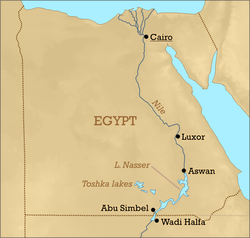
Back Campaña de salvamento de los monumentos de Nubia Spanish Nubiako monumentuak salbatzeko nazioarteko kanpaina Basque
 UNESCO brochure on the anniversary of the campaign | |
 The relocated monuments were from Lower Nubia, roughly between Aswan and Wadi Halfa. The area was entirely submerged by the creation of Lake Nasser | |
| Location | Aswan Governorate, Egypt |
|---|---|
| Region | Nubia |
| Official name | Nubian Monuments from Abu Simbel to Philae |
| Type | Cultural |
| Criteria | i, iii, vi |
| Designated | 1979 (3rd session) |
| Reference no. | 88 |
| Region | Arab States |
The International Campaign to Save the Monuments of Nubia was the relocation of 22 monuments in Lower Nubia, in Southern Egypt and northern Sudan, between 1960 and 1980. This was done in order to make way for the building of the Aswan Dam, at the Nile's first cataract (shallow rapids) which was a necessary infrastructure project following the 1952 Egyptian Revolution.[1] This project was undertaken under UNESCO leadership and a coalition of 50 countries. This process led to the creation of the World Heritage Convention in 1972, and thus the system of UNESCO World Heritage Sites.[2]
The construction of the Aswan Dam was a key objective of the new regime the Free Officers movement of 1952 in order to better control flooding, provide increased water storage for irrigation and generate hydroelectricity,[3] all of which were seen as pivotal for the industrialization of Egypt.
The building of the dam was to result in the creation of Lake Nasser, which would submerge the banks of the Nile along its entire 479 km (298 mi) length south of the dam – flooding the entire area of historical Lower Nubia. This region was home to 22 critical historical sites, including but not limited to the Abu Simbel temples; as well as the temples at Philae, Kalabsha and Amada.
It was described in the UNESCO Courier as "the greatest archaeological rescue operation of all time".[4]
In April 1979, the monuments were inscribed on the World Heritage List as the Nubian Monuments from Abu Simbel to Philae, as one of the second group of properties added to the list (the first 12 had been added in 1978).[5]
- ^ Hassan, Fekri A. (28 November 2007). "The Aswan Dam and the International Rescue Nubia Campaign". The African Archaeological Review. 24 (3/4): 73–94. JSTOR 40743449 – via JSTOR.
- ^ The World Heritage Convention: "The event that aroused particular international concern was the decision to build the Aswan High Dam in Egypt, which would have flooded the valley containing the Abu Simbel temples, a treasure of ancient Egyptian civilization. In 1959, after an appeal from the governments of Egypt and Sudan, UNESCO launched an international safeguarding campaign. Archaeological research in the areas to be flooded was accelerated. Above all, the Abu Simbel and Philae temples were dismantled, moved to dry ground and reassembled. The campaign cost about US$80 million, half of which was donated by some 50 countries, showing the importance of solidarity and nations' shared responsibility in conserving outstanding cultural sites. Its success led to other safeguarding campaigns, such as saving Venice and its Lagoon (Italy) and the Archaeological Ruins at Moenjodaro (Pakistan), and restoring the Borobodur Temple Compounds (Indonesia). Consequently, UNESCO initiated, with the help of the International Council on Monuments and Sites (ICOMOS), the preparation of a draft convention on the protection of cultural heritage."
- ^ Hassan, Fekri A. (28 November 2007). "The Aswan Dam and the International Rescue Nubia Campaign". The African Archaeological Review. 24 (3/4): 73–94. JSTOR 40743449 – via JSTOR.
- ^ Victory in Nubia: the greatest archaeological rescue operation of all time
- ^ Meskell, L. (2018). A Future in Ruins: UNESCO, World Heritage, and the Dream of Peace. Oxford University Press. pp. 71–72. ISBN 978-0-19-064834-3. Retrieved 4 November 2022.
© MMXXIII Rich X Search. We shall prevail. All rights reserved. Rich X Search